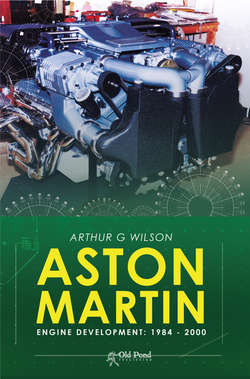Читать книгу Aston Martin Engine Development: 1984-2000 - Arthur Wilson L. - Страница 12
На сайте Литреса книга снята с продажи.
DP1054
ОглавлениеEngine development was ongoing for the 1980 engine range. At this time we had three different cylinder head specifications: the standard V8 with the 1.9" diameter inlet valves, the higher compression Lagonda head with 2.1" inlet vales and the Vantage with the larger valves and the inlet ports bored out to 1.5" diameter. All had slightly different compression ratios. So it would make sense to commonise engine parts where possible.
Using the Lagonda cylinder head as the basis of the standard 1980 type would mean that all engines used the larger inlet valves and that only minor changes to build procedure and a change of camshafts would be required to produce a Vantage version. The Vantage would need new camshafts to optimise the power from the smaller inlet port and to further refine the engine. John Lipman was a camshaft consultant at that time and was commissioned to design new polynomial camshafts for development work. Further refinement to limit piston noise during warm-up would require a new common piston design with barrel skirt rather than the existing taper skirt. Support for the piston side thrust at bottom dead centre could also be extended 0.100" down the bore by reducing the chamfer at the bottom of the liner. With the new piston design we were able to reduce the clearance in the bore from 0.0045" to 0.0035".
Dished valve heads would be part of development, as they had shown a significant reduction in hydrocarbon emissions during earlier development of the federal specification engine due to greater conformity to the valve seat. Tufrided valve stems would reduce wear particularly with the unleaded fuel required by the USA specification cars.
Fuel consumption was improved by almost 2 mpg during the official test cycle, partly by quite a tricky modified ignition system giving part throttle advance and partly due to an improved auto transmission. The ignition system was only tricky to set up in that it used a double acting vacuum capsule for retard at idle and advance during part throttle cruise. The fact that our engine did not make enough vacuum at part throttle to advance the ignition meant that we used the air pump pressure to assist the advance side by pushing from the retard side of the capsule. This required that the advance be switched out at manifold pressure above 1" hg to avoid damage to the engine.
The Motor magazine road test of a Vantage in April 1981 obtained figures of 5.2 seconds to 60 mph and 11.9 seconds to 100 mph; they wrote that it was the fastest production car they had tested up to that date.* Comparisons were made with the Porsche 3.3 Turbo at 12.3 seconds to 100 mph and the Lamborghini Countach at 13.1 seconds to 100 mph. They also rated it as the best handling car.
Figure 3.1 Std V8 Torque Sheet 2
Figure 3.2 Std V8 BHP Sheet 1
Figure 3.3 Vantage Torque Sheet 1.
Figure 3.4 Vantage BHP Sheet 1.
* Ref. Motor Road Test No 21/81.
